Have you ever seen packages of acorn starch in your local Asian market and wondered what it's used to make? Acorn starch is used to make dotorimuk (doh-tohree-mook) a sort of traditional Korean jelly, and, as far as I can tell, it's probably the most widely consumed acorn recipe in the world.
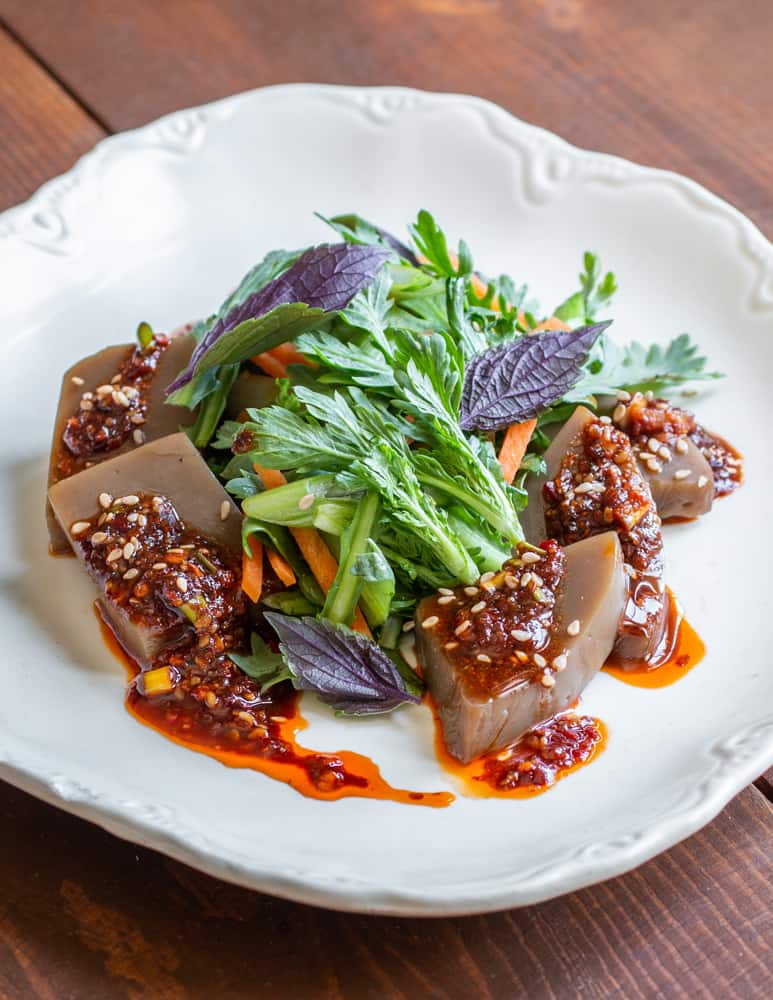
Acorn starch vs flour
Acorn starch is pretty common in Asian markets, but there's a huge difference between starch and flour. Acorn flour is made from the acorns themselves. After drying, shelling, grinding and leaching to remove tannins (for cold-leached acorn flour) the wet mass of acorns is dehydrated, and that's where the flour comes from.
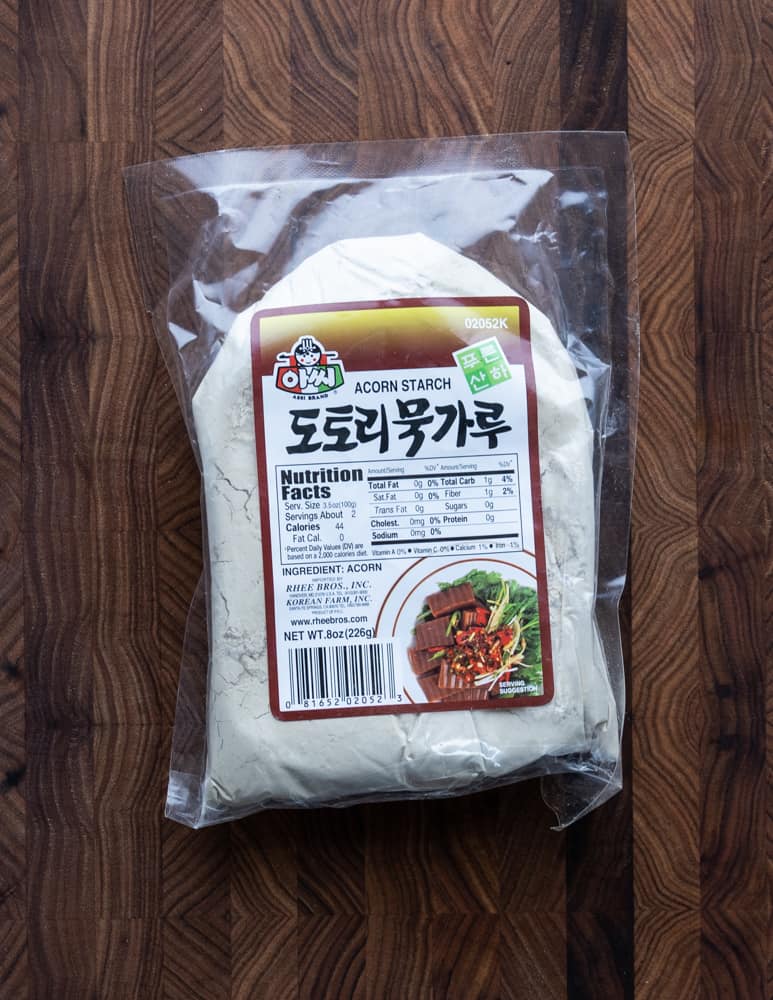
Acorn starch on the other hand should be a quicker process. Whether acorn starch is leached or not I couldn't tell you, but I know it's made from passing water through crushed acorns. If you've ever seen a layer of starch develop on the bottom of a container of cut or shredded potatoes in water, it's basically the same thing.
I can only assume there's a quicker turnaround and less of a processing timeline needed for commercial acorn starch compared to acorn flour making it more economical to sell the latter, but not the former, but that's speculation on my part.
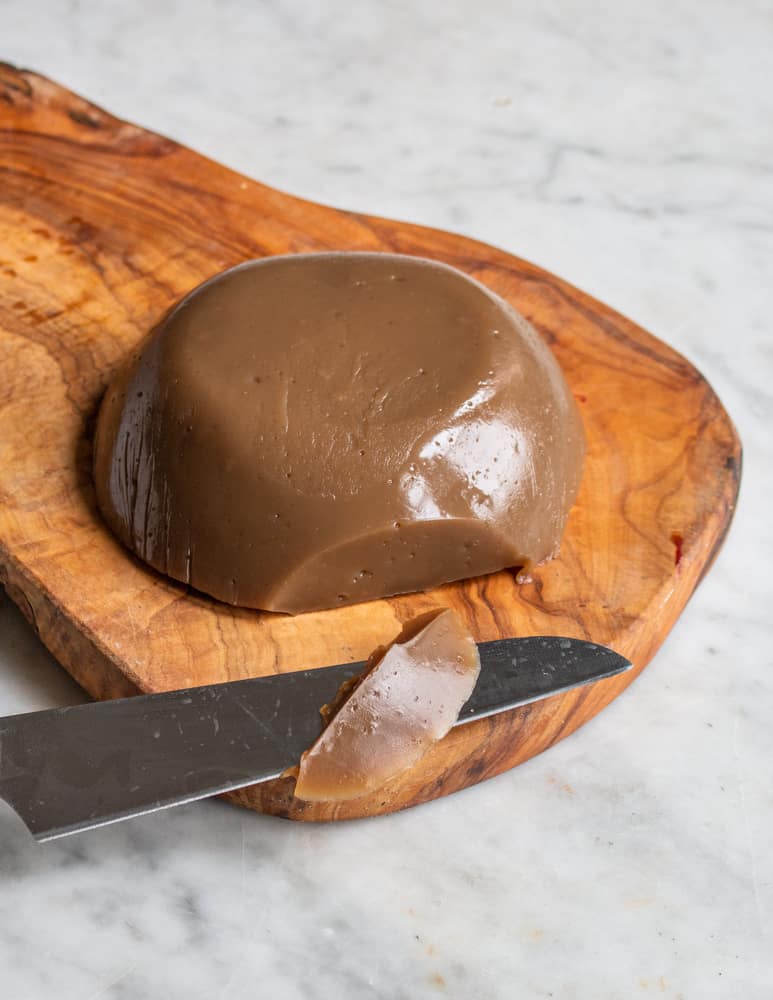
In Korea (the only producer of commercial acorn starch I know of) the starch is used to make dotorimuk, which, as I mentioned, is basically savory acorn jelly.
On the plate it functions as a starch, and is typically eaten with a sauce made from gochugaru chili flakes (also used in kimchi) and a delicious, aromatic salad of chrysanthemum leaves. I have to be honest here, the chrysanthemum leaves are really the star of the show here, and are worth searching out on their own. Look for them at your local Asian grocer.
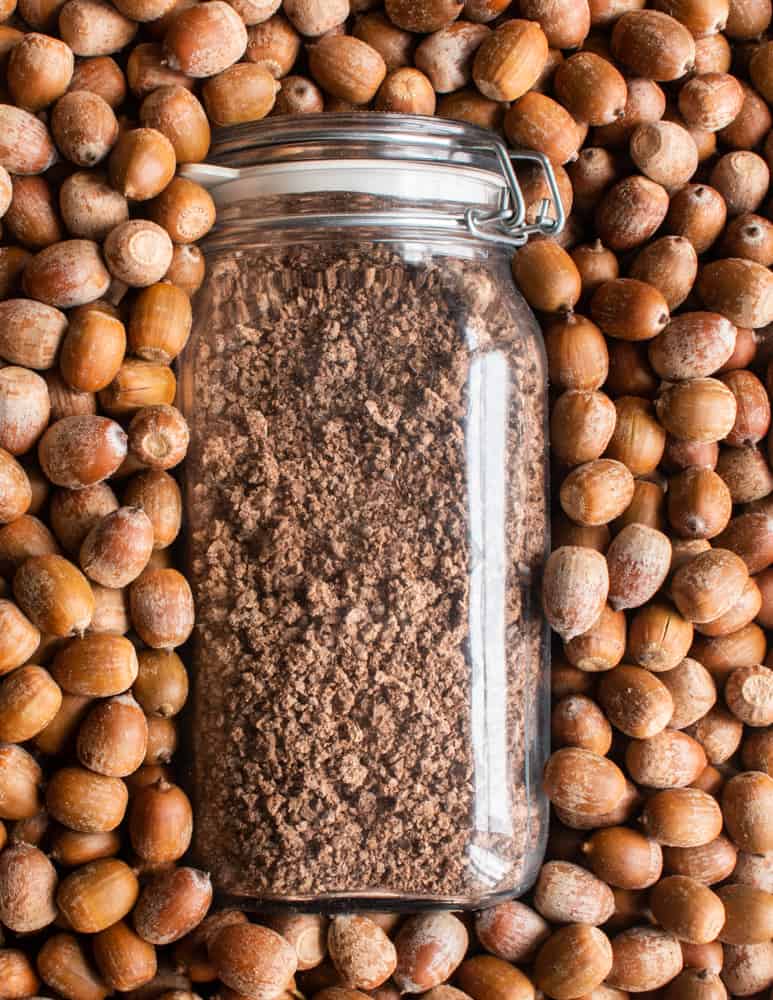
What's acorn jelly taste like? Well, it's interesting. Acorn flour has a very mild flavor that casually reminds me of hazelnuts, albeit much more mild, and the comparison is a bit of a stretch, to be honest. Acorn starch is even more mild-tasting than acorn flour, which means dotorimuk tastes a bit like eating a firm Jell-O that has a very subtle nutty flavor you have to search for.
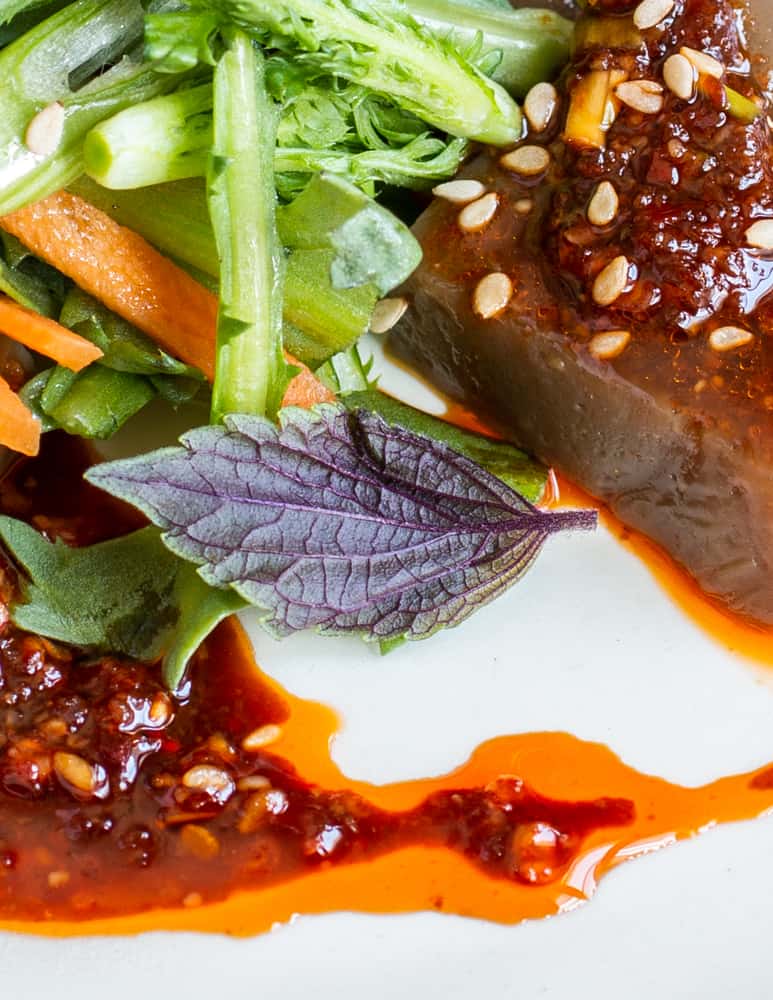
It doesn't taste like much, and it's not supposed to. Similar to how white rice helps fill up a plate and can help be a vehicle for other ingredients, dotorimuk functions as a vehicle for the chili sauce and salad of aromatic greens.
Without the salad and hot chili sauce, it won't taste like much, but the fact that it even exists is fascinating to me, and it deserves credit as a wild-harvested food sold around the world in large volume.
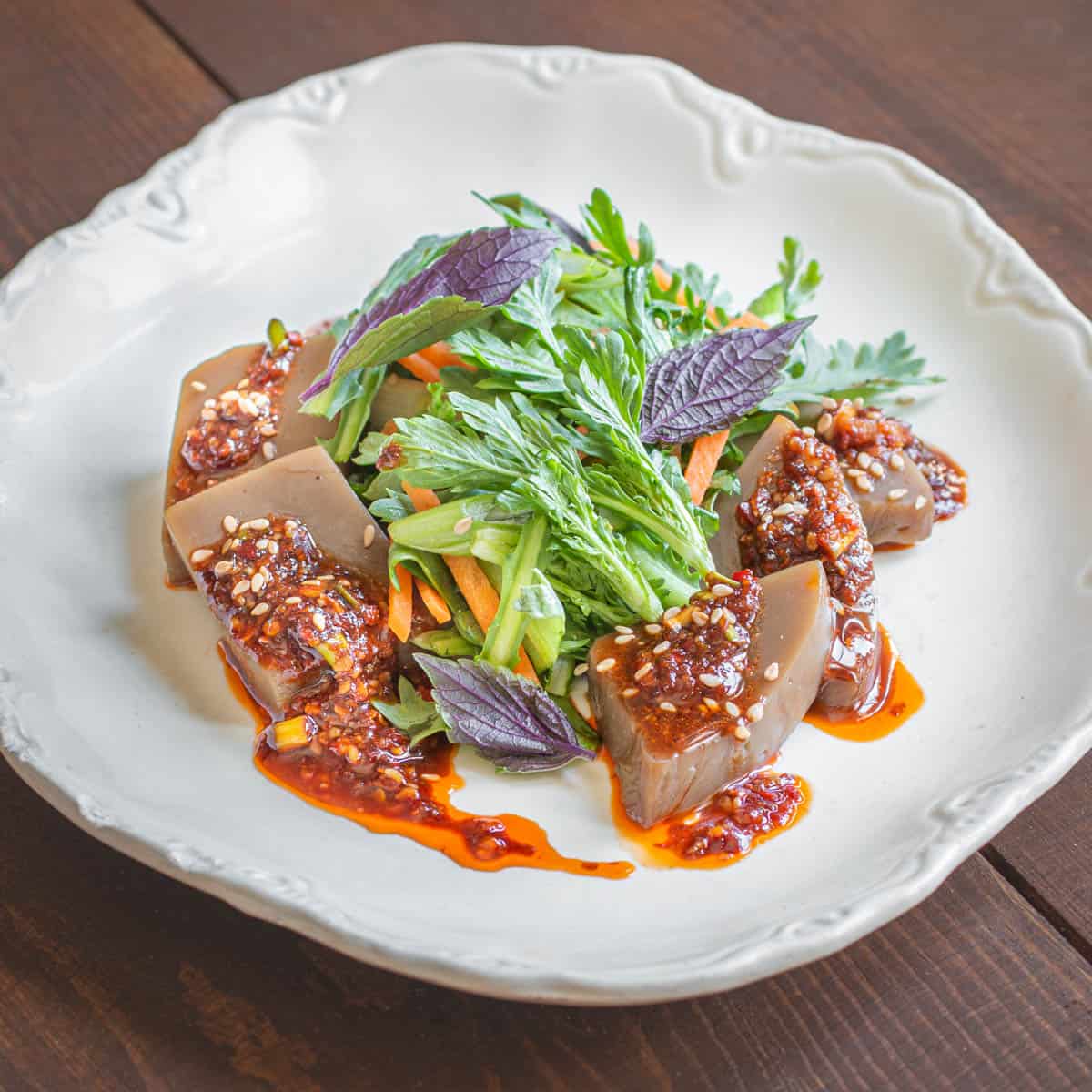
Korean Acorn Jelly with Chrysanthemum Leaf Salad (Dotorimuk)
Equipment
- 1 1 quart mixing bowl or another mold for the jelly
Ingredients
Dotorimuk
- ½ teaspoon salt
- ½ cup acorn starch
- 2 cups water
Dressing
- 1 Tablespoon freshly toasted sesame seeds plus more to garnish
- 1 Tablespoon maple syrup or 1 teaspoon sugar
- 2 Tablespoons gochugaru flakes
- 1 Tablespoon ground Szechuan peppercorns optional
- 2 large cloves of garlic
- 1 inch piece of ginger
- 2 scallions sliced ¼ inch
- ¼ cup soy sauce
- 1 teaspoon fish sauce or equivalent Red Boat brand is my standard
- 2 Tablespoons sesame oil
Serving
- Chrysanthemum leaves tender clusters only, larger stems removed, about 2-3 oz
- 1 oz scallions sliced ¼ inch
- Small handful of finely julienned carrot about 1 oz as a garnish
- Fresh shiso leaves whole if small or torn if large, to taste
- Fresh lime juice or a dash of vinegar to taste
Instructions
Dotorimuk
- Mix the water, starch and salt until completely dissolved, then simmer on medium heat until the mixture has darkened in color, and begins to drop from the whisk like thick whipped cream, about 10 minutes. When in doubt, cook it longer. Transfer the mixture to a small bowl lined with cling film, pour in the dotorimuk, cool, then cover and refrigerate until firm, preferably overnight.
Dressing
- Grind the sesame seeds to coarse powder in a spice grinder. In a bowl, mix all ingredients except the garlic and ginger, then finely grate the garlic and ginger in the mix. The sauce will improve after sitting overnight.
Serving
- To serve, then the dotorimuk into ½ inch slices or whatever size is convenient, then arrange a few on a plate, spooning some of the dressing over the top. Toss the greens with the carrot, scallion and shiso, season with a dash of fresh lime juice and a pinch of salt, arrange on top of the dotorimuk, garnish with the reserved sesame seeds and serve with chopsticks.

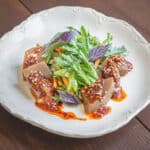
Jano kamciyan
Too bad it wasn't acorn flour. I just bought it on Amazon but I'm afraid to eat it because I don't know if the tannins were removed properly.
Alan Bergo
Taste it. If it's commercial acorn starch it's fine. Acorn starch is produced in factories with a streamlined industrial process. As the acorns are processed fresh they're much easier to leach than dried acorns. I have never had acorn starch taste tannic.
Jake T Robinson
I appreciate learning about this. I am mostly keto/carnivore and was excited to read the ingredients and noticed Acorn Starch is very low in carbs! What else can be made with this ingredient? Cheers
Jake T Robinson
Oh yeah, I find different foods (especially veggies) in my Asian grocery and International grocery and have no clue what or how it is used... Glad you are breaking it down for peeps out here!
Alan Bergo
I don't know anything else. Dotorimuk is a good vehicle so I imagine the dance partners are just switched up. I'm def not an expert on it.
Nancy Oviatt
Alan, thanks for this info about acorn starch, I’ve been trying to get more info about it. I had wondered if it was the layer with the fat you see as the acorn flour settles during each leaching step ( there’s a picture in Hank Shaw’s excellent instructions for making flour). The Korean starch product I have says it’s 14%.
fat.
Thanks for your website and book! I have learned so much. I made raspberry and blueberry vinegar from your recipe and it’s wonderful.
Dorothy Bacon
Neat!
Lee Hoy
This sounds so interesting! I'm making a list for our local Asian Grocery right now. Thanks for sharing. LOVE your blog.
Alan Bergo
Thanks Lee.